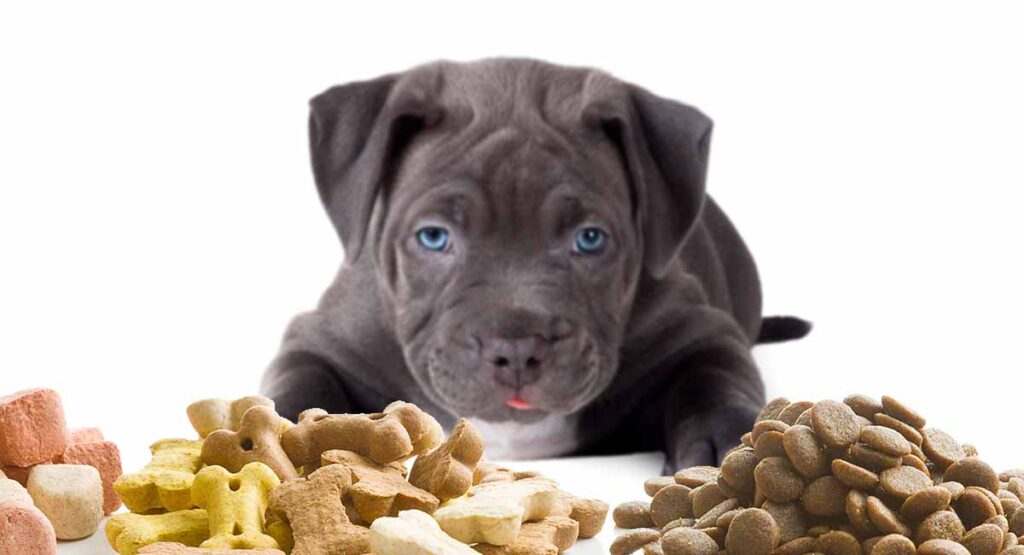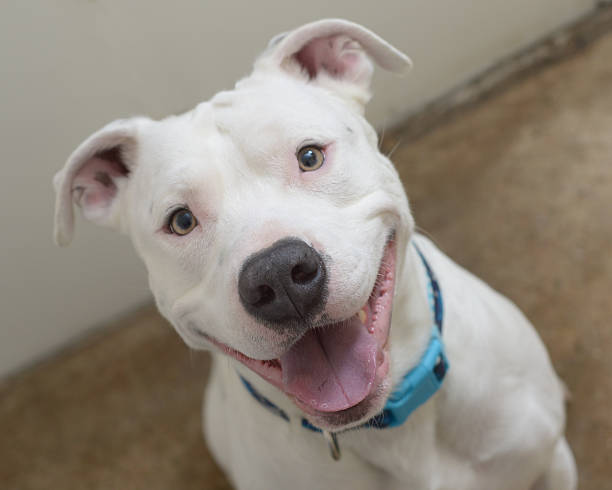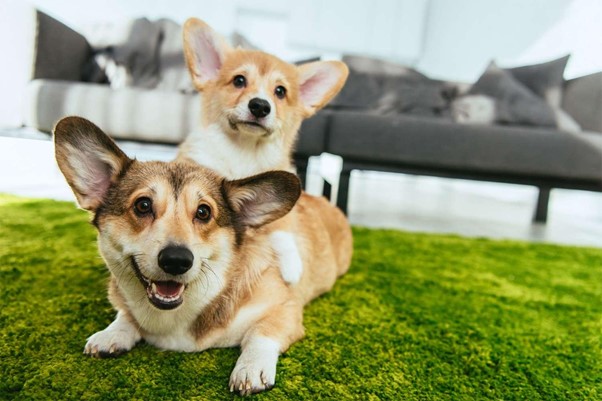American Pit Bull Terrier Dog Breed Guide For Pitbulls Lovers
Author: Caroline Stowe | Updated on 26th August 2022
If you’re thinking about adding an American Pit Bull Terrier to your family or if you’re a lover of APBT, then this is the blog post for you! Here, we’ll provide everything you need to know about these amazing dogs, from their history and temperament to their care and training.
We’ll also dispel some of the common myths about Pit Bulls and show why they make such great pets. So whether you’re just thinking about getting a Pit Bull or you’ve already got one by your side, read on for all the info you need!

Table of Contents
American Pit Bull Terrier and Pit Bull: Are they the same?
This is a commonly asked question, and the answer is no, they are not the same! The American Pit Bull Terrier (APBT) is a recognized breed by the United Kennel Club (UKC), while the term “Pit Bull” is actually a catch-all phrase that can be used to describe several different breeds of dogs, including the APBT, the Staffordshire Bull Terrier, and even the American Staffordshire Terrier.
So if you’re looking for a specific type of dog when you hear the term “Pit Bull,” be sure to ask which breed they are talking about. For our purposes here, we will be focusing on the American Bull Terrier.
History of the American Pit Bull Terrier
The American Pit Bull Terrier has a long and storied history, dating back to the early 1800s. It is believed that they were bred in the early 1800s from crosses between English Bulldogs and Terriers.
The English Bulldog was originally bred in England in the 1600s as a working dog. They were used for bull-baiting, which was a popular sport at that time.
The Terrier is a type of dog that was originally bred to hunt vermin. There are many different types of Terriers, but they all share some common characteristics, such as being small, agile, and tenacious.
The American Pit Bull Terrier is a descendant of the British Pit Bull Terrier. These dogs were originally bred in England in the 1800s for bull-baiting, a now-illegal blood sport in which dogs fought bulls for entertainment.
When bull-baiting was outlawed in 1835, dog fighting became the new “sport” of choice and the Pit Bull Terrier was once again in high demand. To make these dogs more adept at fighting, they were bred to be larger and more muscular than their predecessors.
These “new” Pit Bull Terriers were then imported to the United States in the late 1800s and became popular as working dogs on farms and as family pets. They also became known as “nanny dogs” due to their propensity for being gentle and loving with children.
The American Pit Bull Terrier we know today was developed in the early 1900s by crossbreeding the British Pit Bull Terrier with other terrier breeds like the Manchester Terrier and the Staffordshire Terrier. This resulted in a smaller, more athletic dog that was better suited for dog fighting. The “nanny dogs” positive reputation was ruined in the mid-1900s when these dogs were increasingly used for dog fighting. As a result, many people began to see them as dangerous and aggressive animals.
When dog fighting was finally outlawed in the United States in 1936, the APBT’s popularity began to decline. But this breed had already made a name for itself and many people continued to keep Pit Bulls as pets and working dogs.
Today, the American Pit Bull Terrier is still used as a working dog in many ways, including guarding livestock, hunting, search and rescue, law enforcement, and therapy. In recent years there has been a resurgence of interest in the American Pit Bull Terrier, and many people are beginning to see them for what they truly are: loving, loyal companions.
Pit Bull Terriers make great pets for families with children and are known for their love of children. They are also very intelligent and can be easily trained to perform tricks and agility stunts.
Appearance & Size
The American Pit Bull Terrier is a medium-sized dog with a strong, muscular build. Males typically weigh 35-80 pounds while females usually weigh 30-60 pounds. The height for males is 18 to 19 inches, and 17 to 18 inches for females.
The APBT has a wide, blocky head with small, round ears that are set high on the head. They also have a long, thick tail that tapers to a point.
Pitbull has a short, thick coat that comes in a variety of colors, including black, brindle, blue, red, white, and silver. The coat is easy to groom and only needs to be brushed occasionally.
The breed’s most distinguishing feature is its powerful jaws, which is why they were originally bred for dog fighting. But don’t let this intimidate you – American Pit Bull Terriers are gentle giants who love nothing more than cuddling with their human families.
American Pit Bull Terrier's Temperament & Personality Traits
American Pit Bull Terriers are one of the most popular dog breeds in the country. They are also one of the most misunderstood. They were originally bred for dog fighting. This made them aggressive by nature. However, this aggression is only directed towards other dogs – not people.
Despite their often aggressive appearance, American Pit Bull Terriers are actually known for being extremely loving and affectionate with their families. They make great companions because they are gentle and calm on the inside.
They are also known for their loyal, affectionate, and protective nature towards their family and home. They are also often referred to as “nanny dogs” because they are very friendly and good with children, which is one of the reasons they’re such popular family pets.
Pit Bulls are known for their high energy level. They are brave, courageous, athletic, lively, and love to play. They require a lot of exercise and should have ample space to run, jump, and explore.
APBTs are very intelligent and can be easily trained to do many different things. However, they can be strong-willed and stubborn at times and require patience and consistency when it comes to training.
Like all dogs, American Pit Bull Terriers need early socialization to help them become well-rounded adults. This means exposing them to different people, places, and experiences from a young age.
Doing this will help your APBT learn how to interact with other animals and people, and will make them less likely to be fearful or aggressive in new situations.
Pit Bulls need to be around people to stay happy and well-adjusted, they’re not a good fit for families who will be gone all day. American Pit Bull Terriers, on the other hand, make wonderful, loving, and loyal companions for families who can give them the time and attention they require.
Are Pitbulls smart and how smart are they?
Pitbulls are considered to be one of the smartest dog breeds. They are often regarded as one of the easiest dogs to train. This is because they are very eager to please their owners and have a great desire to learn new things. They can learn new commands with ease, and they are very good at following instructions.
This means that they can be trained to perform a wide variety of tasks, including serving as loyal companions or working dogs. They can even be trained to perform tricks and agility stunts that other dog breeds cannot do.
Life expectancy of a Pit Bull
What is the life expectancy of a pit bull? The American Pit Bull Terrier is a generally healthy breed with an average lifespan of 12-14 years. However, like all dogs, they are susceptible to certain health conditions.
Pit Bull Bite Force
The American Pit Bull Terrier is known for having a powerful bite. They were originally bred as working dogs to to assist with tasks like hunting and herding. Today, they are often used as guard dogs or police dogs because of their strength and determination. The average Pit Bull has a bite force of 328 pounds, which is more than twice as strong as a German Shepherd’s bite and more than enough to take down most prey or criminals. This makes them an excellent choice for protection or as a working dog.
What health problems are Pitbulls prone to?
Some of the most common health issues seen in APBTs include the following:
1. Hip dysplasia – This is a condition in which the hip joint is not formed correctly, leading to pain and stiffness.
2. Allergies – Pit bulls can be allergic to a variety of things, including food, pollen, and dust mites.
3. Eye problems – Pit bulls are prone to eye injuries as well as various eye diseases such as cataracts and progressive retinal atrophy (PRA).
4. Skin allergies – Pit bulls can develop skin allergies to a variety of things, including grass, pollen, and pet dander.
5. Ear infections – The floppy ears of pit bulls make them more prone to ear infections.
6. Heart disease – Some types of heart disease are more common in pit bulls than in other breeds of dogs.
7. Cancer – Pit bulls have a higher than average risk for developing certain types of cancer, such as lymphoma and osteosarcoma.
8. Joint problems – Pit bulls are susceptible to joint problems such as hip dysplasia and elbow dysplasia.
9. Thyroid problems – Pit bulls can develop thyroid problems, which can lead to a variety of health issues.
10. Obesity – Pit bulls are prone to obesity, which can exacerbate many of the health problems listed above. American Pit Bull Terrier should be fed a high-quality diet and given plenty of exercise to help prevent obesity.
The best way to keep your American Pit Bull Terrier healthy is to take them to the veterinarian for regular check-ups and vaccinations, as well as feed them a high-quality diet. You should also make sure they get plenty of exercise to keep their muscles and joints strong. With proper care, your pit bull can enjoy a long and healthy life.
How much exercise do pitbulls need?
All dogs benefit from exercise, but it’s especially crucial for American Pit Bull Terriers. APBTs are bred for strength and athleticism, so they need a lot of activity to stay fit and happy. Playing fetch with them or going for a long walk or running in the park every day is an excellent method to keep them healthy and happy.
Exercising your APBT is not only good for her health, but it’s also great for her temperament. A tired dog is a calm dog, and regular exercise can help keep your APBT from getting restless and destructive. Giving them enough exercise can also help to prevent problem behaviors such as digging, chewing, and barking.
So if you’re an APBT lover, be sure to provide your dog with plenty of exercise at least an hour of exercise a day, preferably more – it will make both of you happier and healthier!
Nutrition & Food for American Pit Bull Terrier

When it comes to food, the American Pit Bull Terrier is not a picky eater. However, they do have some specific dietary needs that must be met to maintain their health. There are a few things to keep in mind when it comes to feeding your Pitbull.
First of all, because of their muscular build, they require a diet that is higher in protein to develop and maintain lean muscle mass. This means that they need food that is high-quality animal protein, such as chicken, lamb or beef.
Additionally, they need plenty of essential vitamins and minerals to stay healthy and active. It’s important to choose a diet that is designed for active dogs. This will ensure that your Pitbull gets the proper nutrition they need to support its energy level and muscle mass.
Pitbulls are also prone to weight gain, therefore it’s essential to stick to a balanced and nutritional diet. You should avoid dog foods that contain fillers or artificial ingredients. These can cause stomach upset and other health problems.
With so many different types of dog food on the market, it can be difficult to know which one is best for your Pit Bull. However, we have done the research for you and evaluated dozens of dog food on the market to bring you the best. Check out our recommendations and reviews on the top 10 best dog food for Pit Bulls.
What to feed puppy Pitbulls?
Puppyhood is an important time for Pit Bulls, as they are growing and developing at a rapid pace. During this time, it is essential to provide them with food that is rich in nutrients and calories to support their growth.
Once they reach adulthood, Pit Bulls can be switched to a maintenance diet that is lower in calories. When it comes to feeding Pit Bulls, it is important to choose a food that will meet their nutritional needs while also preventing obesity. Also remember to adjust the amount of food you give based on your pup’s activity level.
There are a variety of different ways to provide your American Pit Bull Terrier with the proper nutrition they need. One option is to feed them a commercial dog food that is specifically designed for their breed.
However, many people prefer to make their own homemade dog food. This can be done by simply mixing together some high-quality dry dog food with some boiled chicken or other meat and vegetables.
By following these simple guidelines, you can help keep your American Pit Bull Terrier healthy and happy.
Caring for your American Pit Bull Terrier
Your American Pit Bull Terrier is a special dog who deserves the best care possible. Here are some tips on caring for your Pitbulls:
1. Provide plenty of exercise. Pit Bulls need plenty of exercise to stay healthy and fit. A daily walk or run is a great way to keep your Pit Bull in shape and prevent boredom.
2. Feed them a high-quality diet. American Pit Bull Terriers are active dogs and need a diet that is high in protein and fat. Look for a food that is specifically designed for Pit Bulls or active dogs that is appropriate for their age, weight, and activity level. They need a nutritious diet to stay healthy and strong.
3. Keep up with vaccinations and routine vet care. Like all dogs, Pit Bulls need to be vaccinated against common diseases and parasites. It’s also important to take your Pit Bull to the vet for routine check-ups and care.
4. Prevent fleas and ticks. Fleas and ticks can cause serious health problems for dogs, so it’s important to prevent them with monthly topical or oral medications.
5. Train your Pit Bull. Pit Bulls are intelligent, loving dogs that can make great family pets. However, without proper training, they can be destructive and aggressive. Invest in a good obedience class or book to help you train your Pit Bull properly.
6. Spay or neuter your dog. Spaying or neutering your American Pit Bull Terrier not only helps reduce pet overpopulation, but it can also help improve your dog’s behavior. Dogs that are spayed or neutered tend to be calmer and less aggressive than those that are not.
Proper socialization. They may be aggressive towards other dogs, so is important to socialize your Pit Bull from an early age so he can learn how to interact with other dogs and people.
Make sure to provide plenty of toys and playtime opportunities, as this breed loves to play.
Be consistent with training, as American Pit Bull Terriers are intelligent dogs, but they can be stubborn. It is important to be consistent with your commands and rewards to train them effectively.
Brush their coat regularly. Doing so gets rid of dead fur and prevents mats from forming. Not to mention, it also cuts down on shedding!
How to Train your American Pit Bull Terrier
American Pit Bull Terriers are intelligent dogs, but they can be stubborn and headstrong. Enroll in an obedience class to teach your pitbull basic commands and manners.
Be firm with boundaries and be consistent with your commands and rewards to train them effectively. It is important to establish yourself as the leader of the pack from an early age.
American Pit Bull Terriers are motivated by positive reinforcement, so give them a reward when they display good behavior. On the other hand, do not hesitate to correct their actions when necessary. When it comes to discipline, consistency is essential.
Bringing your new American Pit Bull Terrier home
One of the best things about owning an American Pit Bull Terrier is their companionship. They are loyal and protective of their family and make great pets. Here are a few things to keep in mind when bringing your new American Pit Bull Terrier home:
When you first bring your APBT home, be sure to take him or her for a walk around the block. This will help them get used to their new surroundings and will also help them burn off some energy.
Pit bulls need plenty of exercise. Be sure to provide plenty of opportunities for your dog to run and play. Make sure you have plenty of chew toys on hand, too, as APBTs love to chew!
Be prepared to put in some training for your new dog. APBTs can be willful and stubborn at times, so it’s important to start training early and be consistent with it. A good obedience class can help teach your dog basic commands and manners.
Pit bulls are very food motivated. This can be used to your advantage when training your dog. However, it also means that you will need to be careful not to overfeed them.
Pit bulls are notorious for being escape artists. Be sure to secure your yard or home so that your dog cannot get out and potentially harm other pets.
Pit bulls are extremely loyal to their families. They will want to be involved in everything you do. Be prepared to include them in your daily activities.
Most importantly, always remember that an American Pit Bull Terrier is a member of your family and should be treated as such. With proper care and training, they will make wonderful companions for years to come.

Introducing American Pit Bull Terrier to other pets
APBT like all other breeds of dogs, can get along with other household pets if introduced properly. Here are some tips for introducing a new Pit Bull Terrier to other pets in your home:
1. Make sure that all animals in the home are spayed or neutered. This will help to reduce the risk of aggression and fighting.
2. Always introduce the new dog to the other pets one at a time. This will help to avoid any confusion or confrontations.
3. Allow the animals to smell each other and interact through a barrier such as a fence or gate first. This will help them get used to each other’s scent and presence.
4. Don’t force the animals to interact if they’re not ready. Let them take their time and approach each other when they’re comfortable.
5. Be patient and keep an eye on them during their interactions. If things start to get too rough, separate them until they calm down.
With a little patience and understanding, you can help your new Pit Bull adjust to life with other pets in the home. Just remember to take things slowly and let them get to know each other at their own pace.
FAQs
What were pit bull terriers bred for?
Pit bull terriers were bred as working dogs. They were originally used for farm work, such as herding livestock and guarding property, but later became popular as pet dogs and catch dogs in the United States. Their willingness to please their owners and a strong sense of obedience made them good candidates for many different types of work.
Are American Pit Bull Terriers aggressive?
Pit Bulls were originally bred for dog fighting. This made them aggressive towards other dogs – not people. American Pit Bull Terriers are typically very gentle, loving, and loyal to their families. They make wonderful family pets. However, as with any breed of dog, proper training and socialization are essential to ensure that your Pitbull puppy grows up to be a well-behaved canine companion.
Are American Pit Bull Terriers dangerous?
American Pit Bull Terriers are not inherently dangerous. However, they can be if they’re not properly trained and socialized. Pit Bulls were originally bred for dog fighting, so they have a strong prey drive and can be aggressive towards other animals. They also have very strong jaws that can cause serious damage if they bite someone.
This is why it’s important to make sure your Pit Bull is properly trained and socialized from an early age. If you do, they’ll grow up to be a loving and loyal companion that is great with kids and other pets.
How strong is a pitbull's bite force?
The American Pit Bull Terrier is known for having a powerful bite. They were originally bred as working dogs to help with tasks such as hunting and herding. Today, they are often used as guard dogs or police dogs because of their strength and determination. The average Pit Bull has a bite force of 328 pounds, which is more than twice as strong as a German Shepherd’s bite and more than enough to take down most prey or criminals. This makes them an excellent choice for protection or as a working dog.
What are the myths about the American Pit Bull Terrier?
The American Pit Bull Terrier is a dog breed that has been subject to much controversy and misinformation over the years. There are many myths and stereotypes about this breed that have been perpetuated by the media, uninformed individuals, and even some so-called experts. Here are some of the most common myths about the American Pit Bull Terrier:
1. The American Pit Bull Terrier is a vicious and dangerous breed of dog.
This is one of the most common myths about the American Pit Bull Terrier. The truth is that pit bulls are no more aggressive or dangerous than any other type of dog. Studies have shown that pit bulls are actually less likely to bite humans than other popular breeds such as Labrador Retrievers and Golden Retrievers.
2. The American Pit Bull Terrier is a “killer” breed of dog.
Another common myth about the American Pit Bull Terrier is that they are a “killer” breed of dog. This simply is not true. While it is true that pit bulls were originally bred for fighting, they are not naturally aggressive or violent dogs. With proper training and socialization, pit bulls can be gentle, loving, and loyal companion animals.
3. All Pit Bulls are the same.
This is another common misconception. In reality, there are several different types of pit bulls, including the American Staffordshire Terrier, the Staffordshire Bull Terrier, and the American Bully. While these dogs may share some physical similarities, they are actually quite different in terms of personality and temperament.
Poodles are one of the most popular breeds of dogs in the world. They are intelligent, obedient, and loving, making them great family pets. Poodles require a lot of exercise – at least an hour per day – to stay healthy and happy. They also need a lot of mental stimulation to avoid boredom and destructive behavior. Poodles are not suited for apartments or homes without a lot of outdoor space.
Is the American Pit Bull Terrier the right dog breed for me?

American Pit Bull Terriers are one of the most popular dog breeds in the country. They are also one of the most misunderstood. They were originally bred for dog fighting. This made them aggressive by nature. However, this aggression is only directed towards other dogs – not people. In reality, American Pit Bull Terriers are known for being extremely loving and affectionate with their families.
If you are looking for a loving and loyal companion, then the American Pit Bull Terrier is the right breed for you. They make great family dogs and will be your best friend for life. They enjoy spending time with their families and will form a close bond with you and your family. They are often called the “nanny dog” because they are great with children.
They are high-energy dogs that require a lot of physical activity. If you don’t have the time to commit to daily walks or runs, then an American Pit Bull Terrier is not the right breed for you.
Pit bulls are also very intelligent dogs that are quick to learn and easy to train. However, they need firm and consistent guidance. Pit bulls do not respond well to harsh discipline. If you are not committed to dog training then an American Pit Bull Terrier is not the right breed for you.
Pit bulls are also known for being very stubborn. They have a mind of their own and can be willful at times. If you are not prepared to handle a dog with a strong personality, then an American Pit Bull Terrier is also not the right breed for you.
American Pit Bull Terriers are amazing dogs but they are not suitable for everyone. If you are willing to provide them with the love and attention they deserve, then Pit Bull Terriers can be the most loyal and loving lifelong friends by your side.
Final Thoughts
The American Pit Bull Terrier dog breed is an amazing pet to have, and we hope this article has helped you in your journey of deciding if this type of pooch is right for you. We’ve tried to cover a lot of information, but there are always more resources available to help you take care of your dog. They offer extensive coverage on everything related to owning an APBT. If you have any questions or concerns, don’t hesitate to reach out to us or other APTB owners for help – we’re always more than happy to share what we know with those who love this wonderful dog breed just like us.
Disclaimer: This article doesn’t intend to replace professional veterinary advice, nor should it be used as a substitute for veterinary services, diagnosis, or treatment. The content on this website, including information and opinions expressed herein, are intended for general informational purposes only. In case you have concerns or questions regarding your dog’s health and diet requirements, please consult your veterinarian before doing anything that might affect it.
DogLoversPup.com and the writer are not responsible or liable for any damage, liability, costs, or claims arising from any possible consequences of the reader’s action after reading this article.





